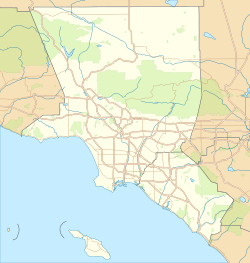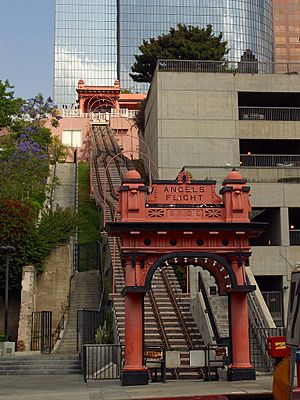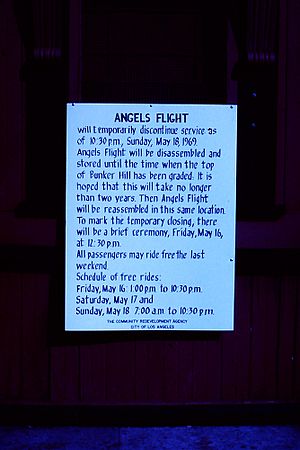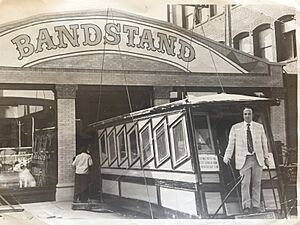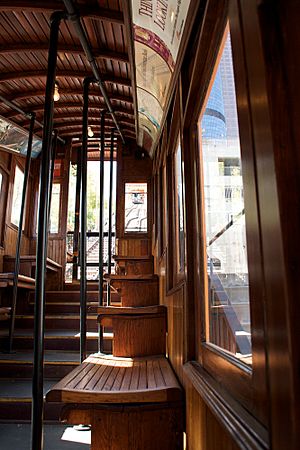Angels Flight facts for kids
|
Angels Flight Railway
|
|
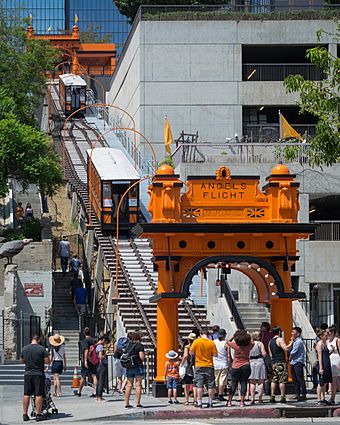
Angels Flight in September 2017
|
|
| Location | Hill Street, Los Angeles, California |
|---|---|
| Built | 1901 |
| Architect | Merceau Bridge & Construction Co.; Train & Williams |
| Architectural style | Beaux-Arts |
| NRHP reference No. | 00001168 |
Quick facts for kids Significant dates |
|
| Added to NRHP | October 13, 2000 |
Angels Flight is a famous and very short railway in Downtown Los Angeles, California. It is a special type of railway called a funicular. This means it has two cars that move up and down a steep hill. The cars are named Olivet and Sinai. They are connected by a cable and move in opposite directions. As one car goes up, the other comes down.
This funicular has been in two different spots in Los Angeles. It always used the same cars and parts of its stations. The first Angels Flight ran from 1901 to 1969. It connected Hill Street and Olive Street. It closed because the area was being rebuilt.
The railway reopened in 1996, a short distance from its first spot. It now connected Hill Street and California Plaza. However, it closed again in 2001 after an accident. It took nine years to get it running again, reopening in March 2010. It closed briefly in 2011 and again in 2013 after a small incident. This led to finding some safety issues.
Before the 2013 closure, a ride cost 50 cents. Many local workers used it to travel between areas. It was also a fun attraction for tourists. After new safety improvements, Angels Flight reopened on August 31, 2017. A one-way ride now costs $1.
Contents
The First Angels Flight
Angels Flight first opened in 1901. It was built by Colonel J.W. Eddy and was called the "Los Angeles Incline Railway." It started at Hill Street and went uphill to Olive Street.
The railway had two bright red "boarding stations" and two cars, Sinai and Olivet. These cars were pulled up the steep hill by strong metal cables. Engines at the top station provided the power. When one car went up, the other came down using gravity.
An archway at the Hill Street entrance said "Angels Flight." This became the railway's official name in 1912. The original Angels Flight was a classic funicular. Both cars were connected to the same main cable. It also had a separate safety cable in case the main one broke. It ran safely for 68 years.
Over the years, Angels Flight had several owners after Colonel Eddy. In 1962, the city's new Cultural Heritage Board named Angels Flight a special historic landmark. This helped protect it.
In 1943, a rare accident happened when a person was on the tracks.
In 1952, a plaque was put up to celebrate 50 years of the railway. It said Angels Flight was the "world's shortest incorporated railway." It also mentioned that it had carried over a hundred million passengers.
Taking Angels Flight Apart
The railway closed on May 18, 1969. This was because the Bunker Hill area was being completely redeveloped. Many old buildings were torn down to make way for new high-rise buildings.
Both cars, Sinai and Olivet, were put into storage. They were kept in a warehouse for 27 years. One car, Sinai, was even displayed in a private museum called "The Bandstand." The city had planned to reopen the railway within two years, but it took much longer.
Rebuilding the Railway
After being stored for 27 years, Angels Flight was rebuilt. It reopened on February 24, 1996. It was placed half a block south of its original spot. The original cars, Sinai and Olivet, were used again. However, a new track and cable system were designed.
An operator inside the upper station controlled the car movement. They made sure the track was clear and collected fares. The cars themselves did not have staff inside. Angels Flight was added to the National Register of Historic Places in 2000.
After an accident in 2001, investigations found that some safety features could have been better. For example, the new design did not have track brakes. Also, some maintenance tests had been stopped. These issues were looked at closely to make the railway safer.
Repairs and Reopening
On November 1, 2008, the repaired cars, Sinai and Olivet, were put back on the tracks. Testing began in January 2009. The California Public Utilities Commission approved its safety certificate in March 2010.
The new system completely replaced the one that caused the 2001 accident. Like the original design, the new system uses a single main cable with one car attached to each end. It also has a second safety cable. Each car now has a special rail brake system as a backup. There is also an extra motor to move the cars if the main motor fails.
Angels Flight reopened to the public on March 15, 2010. Many people were excited about it. In just one month, over 59,000 people rode it. It connected the Historic Core and Broadway areas with the Bunker Hill California Plaza park and the Museum of Contemporary Art.
On June 10, 2011, the railway had to stop operations. This was because the steel wheels on the cars were worn out. New custom-made wheels were installed, and the railway reopened on July 5, 2011.
Reopening in 2017
Plans to bring the railway back into service began in January 2017. Safety upgrades were made to the car doors. A special walkway was also added next to the track for emergencies. Angels Flight officially reopened for public service on August 31, 2017.
Images for kids
See also
 In Spanish: Angels Flight para niños
In Spanish: Angels Flight para niños


